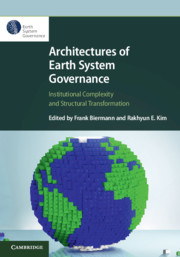Book contents
- Architectures of Earth System Governance
- Series page
- Architectures of Earth System Governance
- Copyright page
- Contents
- Contributors
- Acknowledgements
- 1 Architectures of Earth System Governance
- Part I The Building Blocks
- 2 Intergovernmental Institutions
- 3 International Bureaucracies
- 4 Transnational Institutions and Networks
- 5 Institutional Architectures for Areas beyond National Jurisdiction
- Part II Core Structural Features
- Part III Policy Responses
- Part IV Future Directions
- Glossary
- Index
- References
5 - Institutional Architectures for Areas beyond National Jurisdiction
from Part I - The Building Blocks
Published online by Cambridge University Press: 17 April 2020
- Architectures of Earth System Governance
- Series page
- Architectures of Earth System Governance
- Copyright page
- Contents
- Contributors
- Acknowledgements
- 1 Architectures of Earth System Governance
- Part I The Building Blocks
- 2 Intergovernmental Institutions
- 3 International Bureaucracies
- 4 Transnational Institutions and Networks
- 5 Institutional Architectures for Areas beyond National Jurisdiction
- Part II Core Structural Features
- Part III Policy Responses
- Part IV Future Directions
- Glossary
- Index
- References
Summary
Issues of governance arising in areas beyond national jurisdiction are rising rapidly as priority concerns. In thinking about institutional architectures for these areas, it is helpful to subdivide this class of issues into three subcategories dealing with: (i) international spaces or areas easy to locate in spatial terms; (ii) earth systems that play critical roles in determining the habitability of the planet; and (iii) virtual systems that are increasingly important but difficult to locate in spatial terms. Focusing on one prominent example exemplifying each of these subcategories – the high seas, the earth’s climate system and cyberspace – this chapter seeks to identify lessons of general interest regarding the governance of areas beyond national jurisdiction. It directs attention to the importance of process in contrast to substance, the role of discursive embeddedness, and the importance of balancing stability and agility in a world featuring increasingly complex systems.
- Type
- Chapter
- Information
- Architectures of Earth System GovernanceInstitutional Complexity and Structural Transformation, pp. 97 - 116Publisher: Cambridge University PressPrint publication year: 2020
References
- 4
- Cited by

